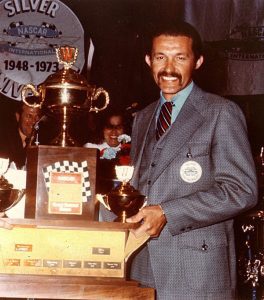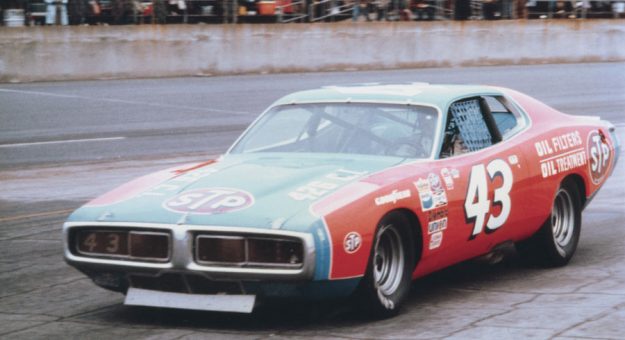Editor’s Note: NASCAR is celebrating its 75th anniversary in 2023. SPEED SPORT was founded in 1934 and was already on its way to becoming America’s Motorsports Authority when NASCAR was formed. As a result, we will bring you Part 25 of a 75-part series on the history of NASCAR as told in the pages of National Speed Sport News and SPEED SPORT Magazine.
“It is not who is fastest that is important, it’s who gets there first,” said Richard Petty after his seventh victory of 1972.
While the defending Winston Cup champ was referring to his Sept. 24 victory at Martinsville (Va.) Speedway, his sentiments summed up the season-long fight for supremacy he waged with Bobby Allison.
Petty began NASCAR’s 24th season with a victory in the Winston Western 500 on the 2.62-mile Riverside (Calif.) Raceway. The recently repainted red and “Petty Blue” STP Oil Treatment Plymouth passed Allison’s Coca Cola Chevrolet on the 110th lap of the fog-shortened event and held on for the first trophy of the season.
After A.J. Foyt drove the Wood Brothers Mercury to victory in the Daytona 500 — a race in which Allison finished 16th and Petty 26th — the next round of the season-long battle between the two Winston Cup heavyweights came in Richmond, Va., at the end of February. Allison started from the pole, but ran into trouble early when he was forced to pit to change a bad tire.
Nevertheless, at the midway point of the 262-mile race, Allison led Petty, who had overcome the wrong tire combination and a one-lap penalty for jumping a restart. Running bumper-to-bumper, Petty swept past Allison to capture the Richmond 500.
However, the Richmond triumph was to be Petty’s last for almost two months and Allison took control of the standings after the race. Allison padded his lead with victories at Atlanta Motor Speedway and Bristol Motor Speedway. At Bristol, the red-and-gold car dominated, leading 458 of 500 laps.
Petty finished third after losing several laps to his rival while repairing damage to his left-front quarter panel.
A Battle At North Wilkesboro
The next time the two antagonists went door-to-door was in the Gwyn Staley 400 at one of Petty’s favorite tracks, North Wilkesboro (N.C.) Speedway. Bobby Isaac started from the pole and dueled with Allison for the first 308 laps, while third-place Petty watched what he later called a great race for the point.
Yet, No. 43 was there for the laurels, not the entertainment.
With 90 laps to go, Petty joined the battle for the lead. In the end, the trio exchanged the lead 18 times before Petty won for the eighth time in his career on the .625-mile track. Allison was second.
In Martinsville the following Sunday (April 30), Allison started on the pole for the fifth time in 10 races, but dropped from the race for several laps to replace a broken brake shoe. Despite this setback, Allison led with only 15 laps remaining. That’s when Allison’s engine blew, allowing Petty to limp to victory ahead of him on only seven cylinders.

Allison added a third victory to his total with an exhausting Mason-Dixon 500 triumph over Petty at Dover (Del.) Downs Int’l Speedway. The top two swapped the lead 12 times before the 416th circuit when Petty went to the pits.
Allison controlled the final 84 laps, but instead of celebrating in victory lane, he sat in his car completely drained by another hard race against Petty.
Petty won the next duel in the Lone Star 500 at Texas World Speedway before finishing second to Allison in 500-mile races at Bristol and Atlanta. These two victories gave the Alabamian the point lead over the North Carolinian.
The tussle between Petty and Allison continued with the Capital City 500 at Richmond on Sept. 10.
Coming in, Allison was on a tear, having won two in a row and five of seven, while Petty endured a 78-day victory drought. In the race, NASCAR’s marquee duo swapped the lead 17 times in the first 390 laps. Two laps later, Petty went inside Allison for the point, but drifted up and hit the No. 12 Chevrolet, which caused Petty’s car to go sideways.
As he slid along the track, his former teammate Baker, who now drove the K&K Insurance No. 71 car, hit the No. 43, elevating the rear axle 4 feet off the track. When Petty’s car was back on all four tires, he amazingly maintained the lead before pitting for repairs. When he returned, Petty won the race. Allison was second.
Petty also banged doors with Allison before winning in Martinsville for the 12th time in his career, but it was the 28th race of the 31-race Winston Cup slate which crystalized the rivalry between the two men. With three laps to go at North Wilkesboro Speedway, Petty struck the first blow-a love tap to the No. 12.
Allison upped the ante with a hard blow, which left red-and-gold scars on the STP Road Runner and followed with another strong shot to the (car) body. This exchange continued for the last three laps of Petty’s narrow victory.
When asked about the latest incident between Petty and himself, Allison was matter of fact: “Petty hit me first and I hit him back.” He called what happened hard racing and nothing more.
Petty & Allison Feud
The current points leader was not so understated and accused Allison of trying to wreck him, but sided with Allison and refused to acknowledge a feud between Winston Cup’s top two drivers.
With three races to go, Allison still had a shot at the title.
Yet, while Allison ran his season victory total to 10 with two crowns in Petty’s backyard, Charlotte and Rockingham, he trailed Petty by 128 in the final point tally. Ultimately, his Winston Cup leading victory total and his 27 top-10 finishes were undercut by the act that he finished second to No. 43 on eight occasions.
Petty’s fourth title bettered the record his father, Lee, and David Pearson both held with three Winston Cup titles. Eight victories and 28 top-10 finishes propelled “The King” to the top again.
The man behind the organization Petty reigned over again retired in 1972. On Jan. 11, Bill France announced his retirement as president of NASCAR and handed the reins to his son, William C. France. Big Bill’s vision and gutty leadership built NASCAR from just another sanctioning body to, arguably, the world’s top race-sanctioning body in 23 years.
Under the 62-year-old France, NASCAR had grown from the room full of members, which first assembled at the Streamline Hotel in Daytona Beach, Fla. On Dec. 14, 1947, to more than 16,000 members and thousands of events at better than 80 tracks in the United States and Canada, paying $6 million in purses in 1971.
